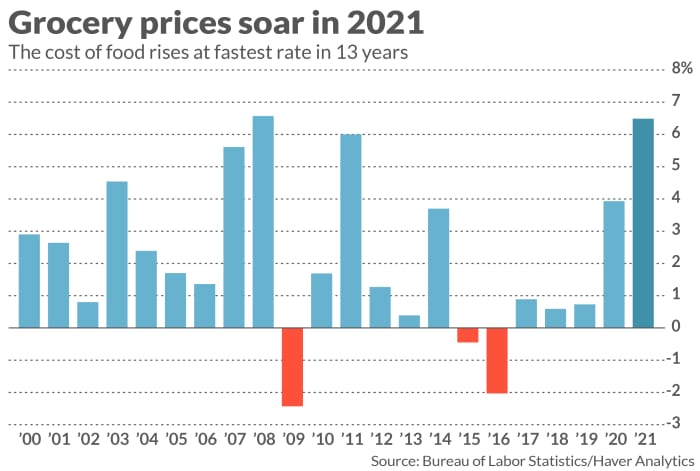This post was originally published on this site
If that ribeye steak or carton of eggs looks a lot more expensive than they did last year, it’s because they are. The prices of groceries jumped 6.5% in 2021 to mark the biggest increase in 13 years.
High inflation has become painful for Americans. They are paying more for rent, gasoline, new and used cars and food, among other things.
The last time food prices rose as fast was in 2008, when a surge in oil prices briefly drove up U.S. inflation. In the decade that followed grocery prices rose very slowly.
The price increases in the past year are especially noticeable at grocery stores since most people shop several times a week. Food is about 14% of the average family’s budget, split between groceries and eating out, government data shows.

The cost of proteins — beef, chicken, pork, fish and dairy — have seen particularly big increases. But the cost of most foodstuffs have risen.
Food prices are unlikely to drop quickly, especially with omicron racing through the economy and forcing millions of people to be absent from work.
Many stores around the country have reported scattered shortages of various products. The problem is the most severe in the Northeast, where several major storms interrupted already strained grocery-resupply efforts and left many shelves bare.
Ongoing labor and supply shortages are unlikely to ease soon, either. Food producers can’t get enough packaging materials and prices for plastic, styrofoam and the like have also risen.
Grocers also can’t find enough workers and many are pushing for higher pay. Employees at Kroger
KR,
in Denver, for example, went on strike for higher pay and benefits.
“As we’ve seen across the economy, product availability and price inflation are being driven by a perfect storm of factors,” said Jim Dudlicek, director of communications at the National Grocers Association.
These include “an ongoing shortage of labor across the entire supply chain, an acute shortage of truck drivers, increased ingredient inputs and occasional disruptions in product packaging production,” he said.


